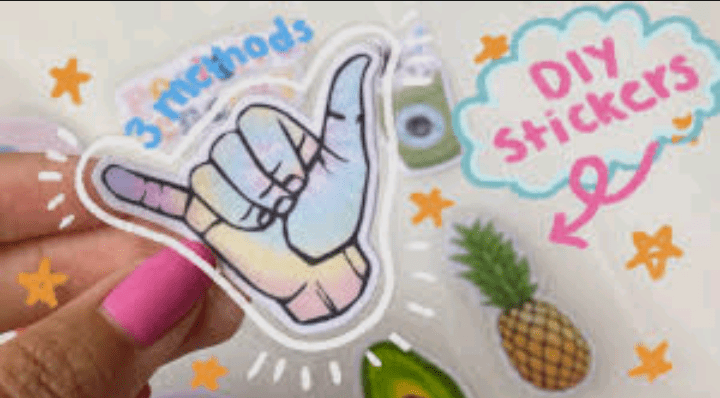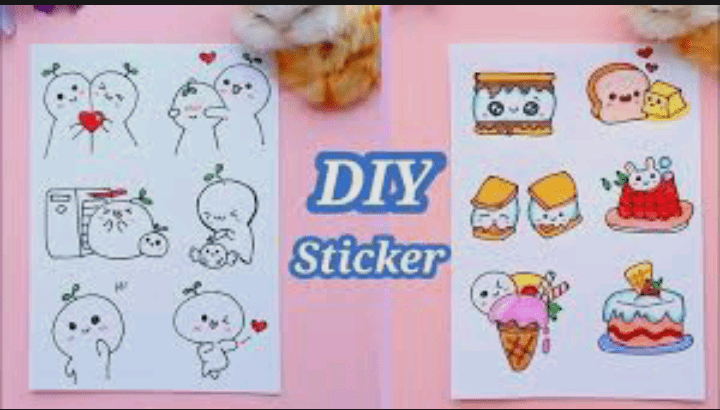Have you ever looked at someone’s laptop covered in an array of stickers and thought, “I wish I could do that”? Well, buckle up because we’re about to embark on a journey into how to make DIY stickers. Making your own stickers isn’t just a craft; it’s a way to infuse your personality into everyday items, turning them into unique expressions of who you are.
In this comprehensive guide, we’re going to break down the process of sticker-making into simple, easy-to-follow steps. From selecting the right materials to honing your design skills, we’ll be your companions on this colorful adventure. So, if you’ve ever dreamt of adorning your notebook with custom creations or personalizing your water bottle with stickers that scream “you,” you’re in the right place.
Stickers aren’t just sticky pieces of paper; they’re tiny canvases waiting to be transformed by your imagination. From witty quotes that make you smile to intricate illustrations that reflect your passions, DIY stickers allow you to showcase your creativity in a tangible, peelable form.
So, whether you’re a seasoned artist or just someone with a penchant for doodling, join us as we explore the joy of sticker-making and discover how each peel can tell a unique and captivating story about you. Get ready to unleash your creativity – one peel at a time!
Read also: Crafting Joy: A Comprehensive Guide to DIY Christmas Wreath
How to Make DIY Stickers

1. Getting Started
A. Understanding the Basics
Before diving into the creative process, it’s essential to familiarize yourself with the basics of sticker making. Stickers typically consist of three components: the facestock (the actual sticker material), adhesive (for sticking), and backing (to protect the adhesive). Additionally, you’ll need access to various tools and materials to bring your sticker visions to life.
B. Essential Tools and Materials
To embark on your DIY sticker adventure, gather the following materials:
- Sticker paper or vinyl sheets
- Cutting tools (scissors, precision knife, or cutting machine)
- Printer
- Design software (Adobe Illustrator, Inkscape, or even free options like Canva)
- Clear adhesive paper (optional, for added durability)
- Laminator (optional, for extra protection)
2. Designing Your Stickers
A. Unleashing Your Creativity
The design phase is where your imagination takes center stage. Consider the purpose of your stickers — are they meant to convey a message, reflect your personality, or simply add aesthetic appeal? Whether you’re into minimalist designs, intricate illustrations, or witty quotes, the possibilities are endless.
B. Choosing the Right Software
Select a design software that aligns with your skill level and preferences. Adobe Illustrator is a powerful tool for professionals, while Inkscape offers a free alternative with robust features. Beginners might find user-friendly platforms like Canva to be an excellent starting point.
C. Creating Your Design
Experiment with colors, shapes, and typography to create a visually appealing design. Keep in mind that simpler designs often translate better into stickers. Consider the size of your stickers and aim for a balance between clarity and detail.
D. Adding a Personal Touch
Inject a bit of your personality into your designs. Whether it’s a doodle that represents a hobby, a favorite quote, or a symbol that holds sentimental value, incorporating personal elements into your stickers makes them uniquely yours.
3. Printing Your Stickers
A. Selecting the Right Paper
Choosing the right sticker paper is crucial for achieving the desired result. Matte sticker paper is ideal for a subtle finish, while glossy paper enhances color vibrancy. Vinyl sheets are waterproof and more durable, making them suitable for outdoor use.
B. Adjusting Print Settings
Ensure your printer settings are optimized for sticker printing. Adjust the print quality and color settings to match the specifications of your chosen sticker paper. Perform a test print on regular paper before using the sticker sheets to avoid wasting material.
C. Printing Your Designs
Load the sticker sheets into your printer and hit the print button. Pay attention to the alignment to ensure your designs are centered on the sheets. If you’re using a cutting machine, make sure the printer and cutting machine are calibrated correctly.
4. Cutting Your Stickers
A. Precision Cutting
Cutting is a crucial step in the sticker-making process. Whether you opt for scissors, a precision knife, or a cutting machine, precision is key. For intricate designs, a cutting machine offers accuracy and efficiency.
B. Hand-Cutting Techniques
If you’re using scissors or a precision knife, take your time and follow the outline of your design carefully. Ensure smooth, clean cuts to enhance the overall appearance of your stickers. Practice on scrap paper if needed before cutting into your printed sheets.
C. Utilizing a Cutting Machine
If you have access to a cutting machine, import your design file into the machine’s software and follow the instructions for cutting. Most cutting machines offer different blade settings for various materials, so adjust accordingly to achieve clean cuts.
Read also: DIY Closet Organizer: Transforming Chaos into Order
5. Adding Extra Touches
A. Laminate for Durability
To prolong the life of your stickers, consider laminating them. A laminator adds a protective layer that makes stickers more resistant to water, scratches, and fading. This is especially useful for stickers intended for outdoor use.
B. Clear Adhesive Paper
For an added layer of protection and a professional finish, apply clear adhesive paper over your stickers. This transparent layer not only safeguards your designs but also enhances their vibrancy.
6. Peeling and Sticking
A. Removing the Backing
Once your stickers are cut and any optional layers are added, it’s time to peel and reveal. Carefully lift the corner of the backing from your sticker, making sure not to damage the edges or design.
B. Placement and Precision
Consider the placement of your stickers carefully. Whether you’re creating a sticker collage on your laptop or adding a single sticker to your water bottle, precision in placement ensures a polished final result.
C. Press and Smooth
After positioning your sticker, press down firmly, starting from the center and moving towards the edges. Smooth out any air bubbles with your fingers or a flat tool, ensuring the sticker adheres seamlessly to the surface.
7. Troubleshooting Tips
A. Preventing Bubbling
To avoid unsightly air bubbles under your stickers, apply them slowly and evenly, smoothing out any bubbles as you go. If bubbles persist, use a pin to gently pierce them and press the air out.
B. Removing Stickers Safely
If you decide to change up your sticker arrangement or need to remove a sticker, do so carefully. Peel from one corner at a time, applying heat with a hairdryer to soften the adhesive if needed. Clean any residue with a mild adhesive remover.
8. Exploring Advanced Techniques
A. Layered Stickers
Experiment with layered stickers by printing and cutting multiple elements separately. This allows you to create dynamic, multi-dimensional designs with different textures and colors.
B. Die-Cut Stickers
For a professional touch, explore die-cutting techniques. Die-cut stickers have unique shapes that complement the design, making them stand out even more. Some printing and cutting machines offer die-cutting capabilities.
9. Showcasing Your Stickers
A. Digital Platforms
Share your sticker creations with the world by showcasing them on digital platforms. Instagram, Pinterest, and Etsy are excellent channels to display your designs, connect with fellow creators, and even sell your stickers if you’re feeling entrepreneurial.
B. Gift-Giving and Trading
Spread the joy of sticker-making by gifting your creations to friends and family. Consider organizing sticker swaps or trades with fellow enthusiasts to expand your collection and discover new styles.
Read also: Waste Resource Recovery Techniques
